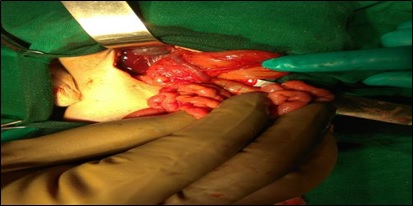Preduodenal portal vein – a cause of antenatally diagnosed duodenal obstruction
Abstract
Preduodenal portal vein (PDPV) is a rare congenital vascular anomaly in which the portal vein passes anterior to the duodenum rather than posteriorly. Generally asymptomatic, PDPV may rarely cause a duodenal obstruction in the newborn. It is usually associated with gastrointestinal tract, cardiac, pancreatic, as well as biliary tract anomalies or may, occur as a single isolated malformation. Till now, only a few cases have been reported with duodenal obstruction and associated anomalies. The present study report one such case of PDPV with multiple congenital anomalies. A full-term, one-day-old baby who had an antenatal history of polyhydramnios, presented to us with abdominal distension and non-bilious vomitings soon after birth. Surgical exploration revealed a hugely dilated stomach, multiple Ladd bands, malrotation of the small intestine, preduodenal portal vein, and an annular pancreas causing external duodenal compression. Intraoperative recognition of PDPV is important because iatrogenic injury during surgery can cause profuse hemorrhage from the vein and may cause damage to the biliary tract or duodenal wall. Prompt evaluation of associated cardiac anomalies is important before surgery. Duodenostomy anterior to the portal vein is the definitive treatment. Studies in animal models (AKR/J mice) have shown an autosomal recessive mode of inheritance.
Downloads
References
His W. Human anatomy and embryology, Chapter III, Organ Histology, Vogel, Leipzig, Germany, pp 1-260 (in German),1885.
Begg A. The anaomalous persistence in embryos of parts of the peri-intestinal rings formed by vitelline veins. Am J Anat.1912;13(2):103-110. doi: 10.1002/aja.1000130203.
Knight H.O. An anomalous portal vein with its surgical dangers. Ann Surg. 1921;74(6):697-699. doi: 10.1097/00000658-192112000-00004.
Bower RJ, Trenberg JL. Preduodenal portal vein. J Pediatr Surg.1972;7(5):579-584. doi: 10.1016/0022-3468(72)90216-3.
Ishizaki, YM. Tanaka T. Okuyama. Surgical implications of preduodenal portal vein in the adult. Arch. Surg. 1994 Jul;129(7):773-5. doi: 10.1001/archsurg.1994.01420310105020.
Ooshima L, Maruyama T, Ootsuki K, Ozaki M. Preduodenal portal vein in the adult. J. Hepatobiliary Pancreat. Surg. 1998;5(4):455-458. doi: 10.1007/s005340050072.
Tsuda Y, Nishimura K, Kawakami S, Kimura I, Nakano Y, Konishi J. Preduodenal portal vein and anomalous continuation of inferior vena cava: CT findings. J Comput Assist Tomogr. 1991;15(4):585-588. doi: 10.1097/00004728-199107000-00011.
Grosfeld JL, Rescorla FJ. Duodenal atresia and stenosis: reassessment of treatment and outcome based on antenatal diagnosis, pathologic variance, and long-term follow up. World J Surg. 1993;17(3):301-309. doi: 10.1007/BF01658696.
Yi SQ, Tanaka S,Tanaka A, Shimokawa T, Ru F, Nakatani T. An extremely rare inversion of preduodenal portal vein and common bile duct associated with multiple malformations. Report of an adult cadaver case with a brief review of the literature, Berlin. Anat Embryo. 2004;208(2):87-96. doi: 10.1007/s00429-003-0377-7.

Copyright (c) 2020 Author (s). Published by Siddharth Health Research and Social Welfare Society

This work is licensed under a Creative Commons Attribution 4.0 International License.


 OAI - Open Archives Initiative
OAI - Open Archives Initiative


